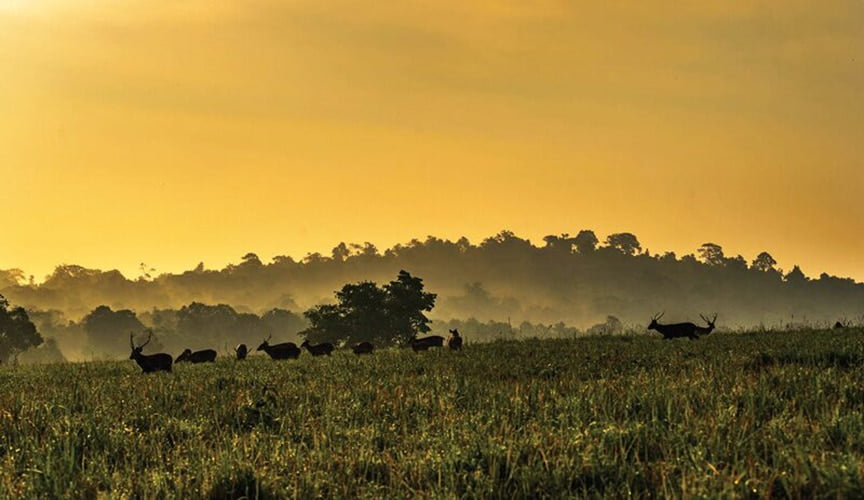The 17th ASEAN Ministerial Meeting on the Environment convened in the picturesque city of Vientiane, Laos, on a warm August 23, 2023, leaving an indelible mark on Thailand’s environmental landscape. The event was imbued with a profound sense of joy as the collective approval resonated through the halls: Phu Khieo Wildlife Sanctuary, Nam Nao National Park, and Phu Kradueng National Park were officially anointed as the 56th and 57th ASEAN Heritage Parks. Amid the gathering of delegates, diplomats, and environmentalists, Thailand stood proud, knowing that its natural treasures had gained international recognition and protection on this remarkable occasion.
In the wake of this historic decision, Jatuporn Burusphat, the astute and passionate Permanent Secretary of the Ministry of Natural Resources and Environment, stepped forth on August 25, his words carrying the weight of commitment and responsibility.

Amidst the lush backdrop of his country’s environmental wealth, he eloquently highlighted the potential inherent in the meticulous management of Thailand’s natural resources. With unwavering determination, he emphasized how this stewardship could lead to the preservation of ecosystemic abundance, eventually evolving into an imperative of regional significance within the ASEAN fraternity. His words served as a rallying call, a reminder that environmental guardianship transcends borders and is a shared endeavor that unites nations under a common purpose.
“Within this pivotal moment,” he articulated, his voice unwavering, “lies the seed of future cooperation, nurturing not only the sanctuaries themselves but also the wellspring of Thailand’s natural endowments.”
The jubilant event echoed with his optimism, reverberating a promise for the future – a future in which harmonious coexistence with nature would remain paramount.
Phu Kradueng National Park, situated within the embrace of Loei province’s tranquil embrace, emerges as a gem within the ASEAN crown. A sentinel of natural wonder, it rises as a sandstone mountain summit, distinctive and unparalleled in the region. Its defining traits are myriad: the rugged sandstone cliffs that embrace the heavens, the vast savannas that ripple like golden waves, and the lush, untamed forests teeming with life. This tapestry of diversity provides a refuge for rare and remarkable flora and fauna. Among them, the serow roams with regal elegance, and the elongated tortoise, a survivor from the annals of time, finds solace. Yet, it is not just the wildlife that finds solace here; cultural traditions have intertwined with the landscape, shaping practices such as the serene act of pouring water on Buddha pictures, a ritual that further deepens the sanctity of this living testament to the harmonious union between nature and culture.

The echoes of Phu Kradueng’s unique tapestry resonate far beyond its borders, leaving an indelible mark on those who venture into its embrace.
The scope of Phu Kradueng’s significance is expanded through the lenses of Phu Khieo Wildlife Sanctuary and Nam Nao National Park, nestled harmoniously within the province of Phetchabun. These bastions of biodiversity, verdant and vibrant, share a commonality in geography yet exude distinct identities shaped by the hands of time and nature’s artistry.
Within these verdant realms, a staggering 96.65% of the land is veiled in the embrace of forests – a testament to the enduring power of nature’s hand in shaping these landscapes. However, it’s not just the expanse of the forest that captivates the heart; it’s the intricate mosaic of geology and cave formations that adds depth to these natural narratives.
In these sanctuaries, the harmony of nature’s composition is unveiled in myriad forms. Rare plant species such as the Champee Sri of Thailand Hermit’s cauldron, an exquisite floral treasure, thrive. Ancient pines, venerable custodians of history, stand tall, their wisdom a testament to the passage of time. Yet, the forests do not stand alone in their splendor; they cradle a rich tapestry of wildlife within their embrace. Marbled cats move with a feline grace, chamois traverse the rugged terrain with resilience, gazelles exude a delicate beauty, and clouded leopards, elusive and enigmatic, find solace in these havens.
These parks narrate a story not only of ecological splendor but also of cultural heritage. The region pulses with the beat of tradition, and activities like pouring water on the Buddha picture reverberate as a living connection between past and present, bridging generations through shared practices.
As the sun sets over these sanctuaries, painting the sky in hues of crimson and gold, one can’t help but be humbled by the majesty of nature’s handiwork and the resilience of life that thrives within these protected realms.
With the inclusion of Phu Khieo Wildlife Sanctuary, Nam Nao National Park, and Phu Kradueng National Park, Thailand’s roster of ASEAN Heritage Parks proudly stands at nine, each an ambassador of the country’s commitment to environmental conservation. This distinguished list includes names that resonate with every lover of nature: the sprawling expanse of Khao Yai National Park, the pristine shores of Tarutao National Park, the enchanting islands of Mu Koh Surin-Mu Koh Similan – Ao Phangnga National Parks, the majestic Kaeng Krachan Forest Complex, the coastal marvels of Hat Chao Mai National Park – Mu Koh Libong Non-hunting Area, the primeval beauty of Khao Sok National Park, the dreamlike Mu Koh Ang Thong National Park, and the symbiotic duo of Phu Khieo Wildlife Sanctuary – Nam Nao National Park of Thailand and Phu Kradueng National Park.

The ASEAN Heritage Parks stand as more than mere conservation zones; they are testaments to the commitment of nations within the ASEAN region to preserve the irreplaceable natural heritage that unites them. Born from a vision seeded in 1978, they have matured into a reality that spans borders, bridging differences under the banner of environmental stewardship. The formal establishment of ASEAN Heritage Parks was solidified through the ASEAN Declaration on Heritage Parks and Reserves on the 29th of November, 1984. This proclamation birthed a list, the inaugural eleven, a roster of the first protected areas to fall under the embrace of the AHP Programme.
Thus, within the intricate mosaic of ASEAN’s cultural and ecological diversity, these parks stand as vivid brushstrokes, coloring the canvas with the vibrancy of life itself. Their recognition goes beyond accolades, echoing the eternal truth that nature knows no boundaries, and its preservation requires collective determination, mutual respect, and an unwavering commitment to safeguarding the precious tapestry of life.











